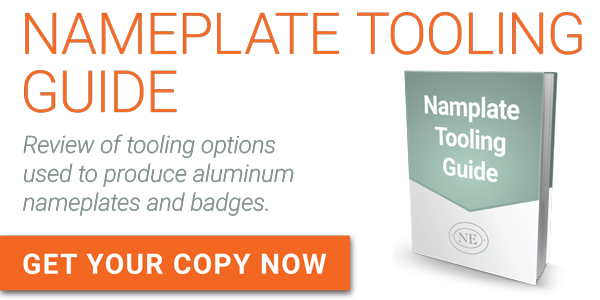How to Hide the Edge of Aluminum Nameplates with a Recess
Hiding the Silver Edge
Aluminum nameplates and trim will show a silver edge when the part is blanked out of the decorated sheet. To hide this edge, a common solution is to design the end product with a recessed area into which the aluminum is placed. This makes the aluminum nameplate capable of sitting flush with the housing and a near-seamless look where the two surfaces meet. It is a cost effective way to keep tooling operations and investment minimal and avoid forming over or rolling the edge of the aluminum. Additional benefit is the recess helps with alignment and location of the nameplate or trim.
In the case of this MP3 player trim, transparent black tint is printed over engine turned aluminum with protective high gloss top coat to withstand being handled often. A slight form at the bottom allows the part to follow the contour of the product for a smooth look and feel. Pressure sensitive adhesive with a peel-off liner provides secure attachment to the housing. The end result is a premium look for a high profile consumer electronic product.
Considerations
Here is an exerpt from the Aluminum Nameplate Tooling Guide with important tolerances and elements to review when designing a nameplate to fit into a recessed area. Taking these into consideration will help produce a manufacturing-friendly design which also will have consumer appeal.
● Depth of the recess should allow for the aluminum to sit just inside to keep the edge from showing. Typically aluminum thickness of .018" or .023" is used for nameplates and trim. Thickness options from .012" - .060" are available.
● A smooth surface within the recess helps attachment and bonding. Pressure sensitive adhesive is a common attachment method. Other options include heat activated adhesive, using a thicker foam adhesive to fill in the recess or a molded backer can be reviewed based on your specifications.
● Any forming or embossing requirements should be reviewed with tooling for recommendation and review of appropriate tolerances. This is also important to confirm amount of contact area that will be available for adhesive attachment. The more contact area available, the more secure the bond.
Hiding the silver edge of aluminum trim and nameplates doesn't need to be a stressor in your design. With the information above, you should see that a recess in the product housing can work with the decorated aluminum design for an attractive look.
Ready to review further? Great! Let's talk!
Subscribe to Nameplate Blog
- 2021 (1)
- 3D (4)
- Adhesives (11)
- Aluminum (129)
- Aluminum In-mold (9)
- Aluminum Trim (41)
- Anodize (4)
- Appliance (12)
- Appliqué (5)
- Archive (35)
- Artwork Submission (4)
- Assembly (6)
- Automotive (35)
- Backlit (5)
- Boats (6)
- Brass (8)
- Brushed Aluminum (19)
- Carbon Fiber (2)
- Classic (1)
- Coined (5)
- Color Development (25)
- Computers (13)
- Cosmetics (24)
- Custom Patterns (11)
- Customization (16)
- Customized Patterns on Aluminum (2)
- Debossing (13)
- Diamond Cut (22)
- Digital Printing (2)
- ebook (4)
- Electronics (23)
- Embossing (53)
- Etched (20)
- Exterior (9)
- FAQ (29)
- Faux Finish (1)
- Faux Finishes (7)
- Favorite Nameplate (20)
- Furniture (9)
- Gauges (5)
- Gloss (4)
- Hang Tag (1)
- IDSA (1)
- In-mold Decoration (5)
- Individual Letters (7)
- Inlay (1)
- Key Fob (1)
- Labels (10)
- Large Vehicle (4)
- Laser Etch (2)
- Lithography (3)
- Match Box Cover (6)
- Materials and Processes (118)
- Mechanical Finishes (51)
- Medical Equipment (10)
- Metallic (8)
- Motorcycle (11)
- Nameplate (175)
- Nameplate Examples (54)
- Nameplate Tools (7)
- Outdoor Equipment (4)
- Overlay (7)
- Packaging (15)
- Patina Finish (3)
- Plastic (1)
- Plastic Trim (3)
- Point of Purchase (8)
- Polycarbonate (10)
- Process Color (16)
- Promotional Products (38)
- Prototypes (2)
- Recreational Vehicles (6)
- Resources (11)
- Safety Labels (2)
- Selective Patterns (10)
- Sill Plate (6)
- Sports Equipment (9)
- Stainless Steel (17)
- stock dies (10)
- Surfaces (4)
- Sustainability (1)
- Technical (1)
- Telecommunications (9)
- Testing (3)
- Texture (15)
- Top 10 (9)
- Woodgrain (2)









